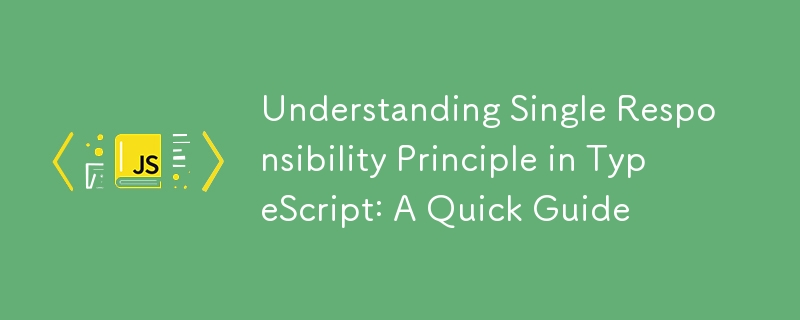了解 TypeScript 中的單一職責原則:快速指南
- WBOYWBOYWBOYWBOYWBOYWBOYWBOYWBOYWBOYWBOYWBOYWBOYWB原創
- 2024-08-26 21:40:05934瀏覽

單一職責原則的主要定義是,A 類應該只有一個改變的理由。讓我們分解一下這個陳述以便更好地理解。
假設我們有一個類別來操作我們傳遞給它的文本,單一職責原則規定我們創建的類別應該只負責操作文本,它執行的任何其他操作都不應該是班級。
讓我們舉一個這樣的類別的例子,看看我們如何重建它:
class TextManipulator {
text: string;
constructor(text: string) {
this.text = text;
}
appendText(newText: string) {
return this.text.concat(newText);
}
findAndReplace(word: string, replacementWord: string) {
if (this.text.includes(word)) {
this.text.replace(word, replacementWord);
}
return this.text;
}
printText() {
console.log("The text is ", this.text);
}
}
在上面的程式碼中,我們可以看到該類別也在執行列印操作。這打破了單一職責原則。我們可以透過建立兩個新類別來重構程式碼
class TextManipulator {
private text: string;
constructor(text: string) {
this.text = text;
}
appendText(newText: string) {
return this.text.concat(newText);
}
findAndReplace(word: string, replacementWord: string) {
if (this.text.includes(word)) {
this.text.replace(word, replacementWord);
}
return this.text;
}
getText() {
return this.text;
}
}
class PrintText {
formattedText: TextManipulator;
constructor(formattedText: TextManipulator) {
this.formattedText = formattedText;
}
printText() {
console.log("The text is ", this.formattedText.getText());
}
}
在重構的程式碼中,我們有兩個單獨的類別正在執行單獨的操作。
為什麼採取單一責任原則
採用單一職責原則,我們可以實現以下目標:-
- 更好的程式碼組織與可維護性
- 更高的程式碼可重複使用性
- 提高了可讀性
- 更輕鬆的調試和測試
需要考慮的事項
實施單一責任原則的技巧是要知道我們類的單一責任是什麼。然而,每個開發人員都有他/她對類責任的願景,並且由於我們沒有任何關於如何實現的說明,所以我們只能有自己的解釋。
在某些情況下,我們將兩個類別分開,實際上從業務或架構的角度來看,它們在做同樣的事情。這可以創建更複雜的程式碼,兩個類別緊密耦合彼此,從而減少SOLID原則
的唯一目的關鍵是創建新類別時不要想太多
以上是了解 TypeScript 中的單一職責原則:快速指南的詳細內容。更多資訊請關注PHP中文網其他相關文章!
陳述:
本文內容由網友自願投稿,版權歸原作者所有。本站不承擔相應的法律責任。如發現涉嫌抄襲或侵權的內容,請聯絡admin@php.cn

